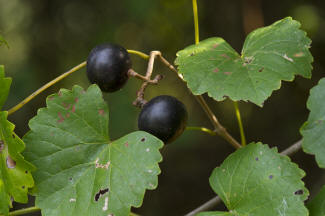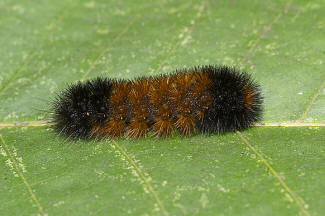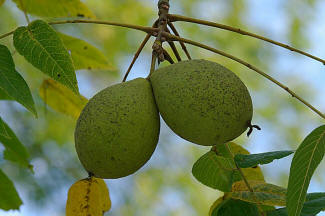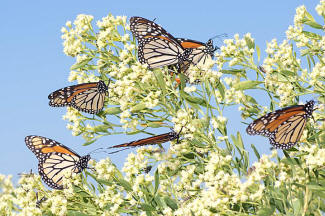PROFILES IN NATURE
Muscadine Grape
Photo Credit –
www.kentuckyupclose.com
It seems a little early but I have noticed some ripe Muscadines,
Vitis rotundifolia falling to the ground recently.
The muscadine is one of two common wild grapes in our area. The
other is called a wild grape or possum grape and is much smaller and
more tart tasting than the muscadine. When comparing the two vines
possum grapes have a much larger leaf and the grapes grow in hanging
bunches similar to store bought grapes but just smaller. Muscadines
usually grow individual grapes or maybe have two to four individual
fruits on the same stem. Some cultivars that are grown commercially have
several grapes in a bunch but the wild ones I have seen here are of the
variety that have one or two.
The grapes range in size from half to three quarter inches across
and are a purple/black color when ripe. They are very thick skinned and
have seeds but are very sweet and rival any store bought grape for
flavor. The skin is tough though so is not usually eaten but instead the
contents are squeezed out into your mouth. Vines grow to the tree tops
so the ripe grapes are usually found on the ground unless a vine can be
located growing in a fencerow or other such low support. My vine at home
was in a tree that the 2009 ice storm broke over and brought the vines
to the ground, these vines have grown back up the broken tree and formed
a large shrub structure so the grapes are at eye level.
Used fresh, in jellies, jams, and wines the muscadine has been
utilized since early European Settler days. Prior to that Native
Americans enjoyed the sweet treat. Not only are the grapes themselves
eaten but young shoots and leaves may be boiled and eaten as well. The
muscadine is not only good to eat but is good for one as well as it
contains several beneficial antioxidants and vitamins. So when out
enjoying this cooler weather keep an eye peeled for the muscadine grape.
As usual when
describing edible or medicinal properties I must add the following
disclaimer, neither the paper nor myself are responsible for the
mis-identification and/or possible untoward effects from eating or
otherwise utilizing wild plants.
By Jack Glisson
Published in The Ballard County Weekly 10/01/2014
PROFILES IN NATURE
Woolly Bear Caterpillar
Photo Credit –
www.kentuckyupclose.com
A sure sign that fall is approaching is when one starts seeing
the Woolly Bear Caterpillars,
Pyrrharctia isabella crossing roadways. As fall approaches these
caterpillars go roaming in search of a place to over winter. They
produce a chemical that protects their tissues from damage during
freezing. Come spring the woolly bear will thaw out and emerge then spin
a light brown cocoon and pupate inside. When mature the pupa will hatch
into the adult form which is a light brown moth called a Isabella Tiger
Moth. The adult moths only live for a few days during which they mate
and lay eggs so the process can start all over again.
Woolly bear caterpillars feed on a variety of grass and weeds. As
the young caterpillars grow they must shed their skin. Each shedding or
instar as it is called replaces the old skin with a newer and larger
one. In this particular caterpillar with each molt the light colored
band gets wider so that in the late instar near winter the brown band is
at its widest.
The varying size of the
brown band has led to several legends about the caterpillars ability to
forecast winter weather. Supposedly a wider brown band means a mild
upcoming winter. I suppose an early winter could prevent the caterpillar
from cycling through all of its instars and hence have a narrower brown
band? Maybe I just need to get a Federal Grant and study that theory?
When handled the woolly bear will curl up and play dead. The
bristles or setae as they are called,
are harmless to most people but if handled care must be taken not
to rub you face or around your eyes before washing your hands as these
bristles can then become quite a nuisance. Some people have an allergic
response to the bristles if exposed in tender or thin skin areas.
I was seeing several of these caterpillars during the last cool
spell. With the predicted cooling off I think larger numbers will again
be crawling around. Just in case the old rural legends are true - I want
to see large, wide brown bands on all of them!
By Jack Glisson
Published in The Ballard County Weekly 10/08/2014
PROFILES IN NATURE
October 8th Lunar Eclipse
Photo Credit –
www.kentuckyupclose.com
Have you ever wondered what the difference is between the phases
of the moon and a lunar eclipse?
Most folks see the moon on a daily basis as it cycles through its
phases. Sometimes it looks larger than normal and sometimes there is no
moon at all. Many however don’t give a second thought to the factors
involved in the changing view.
First, what causes the moon to sometimes appear much larger? We
all know that the moon orbits around the earth. What many don’t realize
is that this orbit is not round but elliptical. So at times when the
moon looks large it is actually in the portion of its orbit that brings
it closer to earth. When it looks smaller it is on the outer loop of
this orbit. The distance of the moon from earth varies 26,465 miles!
This helps explain why tidal changes vary so much.
What causes lunar phases? A common mis-conception is that lunar
phases are caused by the earths shadow. This is not the case, lunar
phases are caused by the shadow of the moon itself. Picture yourself
standing in one place looking toward the sun, if the moon is located
directly to your right or left only the portion that is facing the sun
is lit because the back half is shadowed by itself. If the moon was
positioned behind you and you turned and looked the entire surface would
be lit and there would be a full moon. As the moon completes the circle
and is between you and the sun (not directly in line as this would be a
solar eclipse) you are observing the shadowed back side and this is a
new moon or no visible moon. The entire lunar cycle takes roughly 29.5
days to complete.
Now for what prompted this weeks column, a lunar eclipse.
Occasionally, the moons orbit passes through the shadow of the earth. In
other words the earth is between the moon and sun. The time it takes for
the moon to enter into and come out of the shadow cone depends on if it
passes through the center or edge of the shadow and its distance from
earth, usually 4 to 6 hours. One would think that the moon would be in
total darkness at this time but another factor kicks in. As light from
the sun passes through the earths atmosphere it is diffused and bent and
causes an indirect lighting on the moon. Although the moon is located in
the earths shadow it is dimly lit by this circle of light around the
earth. This is the reason the moon is a reddish color during a total
eclipse.
By Jack Glisson
Published in The Ballard County Weekly 10/15/2014
PROFILES IN NATURE
Photo Credit –
www.kentuckyupclose.com
Walnut or Butternut?
This time of year in KY one can see trees hanging full of
walnuts. Or denting your car if you accidently park under a tree!
The Black Walnut,
Juglans nigra, is common across all of Kentucky. Another
similar tree the Butternut,
Juglans cinerea
is a bit more scarce. Further east in the state a few more can be found
but no where in the same numbers as Black Walnuts.
Black Walnuts and Butternuts are both native to North America.
Most of the store bought walnuts are of a different variety though, an
imported English Walnut is preferred to market due to the thinner shell
and ease of removing the nut kernels. Black Walnuts have round nuts
whereas the butternut as is shown here has an oval shaped nut. Both are
good to eat. After removing the outer husk they should be washed and
then allowed to dry and cure for around two weeks somewhere out of the
sun.
Another use for Walnut trees is for lumber. The Dark color and
swirling grain make it valuable for such things as gun stocks and
furniture. The husk from around the nut has been used for dyeing
clothes, staining steel traps, and as a treatment for roundworm and
other skin conditions.
Black Walnut trees can live for one hundred years and grow to
sixty feet tall. Butternuts can live for seventy five years and attain a
height of one hundred feet. Another common name for the butternut is
white walnut.
Both of the nuts are flavorful and have a bit stronger taste than the English walnut. Although a little more difficult to shell than the store bought variety the wild walnuts provide a free and delicious treat. Sure would be a great addition to some Christmas Fudge!
By Jack Glisson
Published in The Ballard County Weekly 10/22/2014
PROFILES IN NATURE
Monarch Butterfly
Photo Credit –
www.kentuckyupclose.com
It’s the time of year that one may look to the sky on a clear
calm day and notice butterflies fluttering in the wind. Sometimes there
may be only one or two but occasionally several can be seen together. If
they are very high in the sky you are likely seeing Monarch Butterflies,
Danaus plexippus,
during their fall migration.
Monarchs, like other butterflies, undergo four life stages. The
adults mate and lay eggs, once the eggs hatch the larvae or caterpillars
feed and grow, the final stage or instar of the caterpillar forms a pupa
or chrysalis, the adult emerges from the chrysalis to start anew. Unlike
other butterflies though, the monarch goes through four generations per
year. Other butterflies may undergo multiple generations but this is
usually confined to one area.
Starting in the spring, during February and March, millions of
butterflies that have over wintered in Southern California and Mexico
start flying north and east. They will mate and be looking for food
plants on which to lay their eggs. Once the eggs hatch the young
caterpillars will mature in about two weeks and form a chrysalis. An
adult butterfly will emerge from the chrysalis in nine to fourteen days
and continue flying north and east, mate, lay eggs and die. The lifespan
of these butterflies is only two to six weeks. As these eggs hatch into
the third generation the life cycle is identical to the second with the
range continuing east and north following emergence of their food
plants. When the third generation’s eggs hatch though there is something
special about this fourth generation. These adults will start working
their way south and eventually end up in their wintering grounds in
Mexico and Southern California where they will over winter and be the be
the ones to start the northern migration the following spring. This
generation may live for six to eight months. This is the only generation
to migrate. The butterflies that fly south have never been there, they
are the off spring from three generations prior that came from the
wintering grounds.
The favorite food of Monarch Caterpillars is milkweed. They
absorb a poison from that plant and carry it into the adult butterfly
stage. This is apparently successful enough that another butterfly
called the viceroy, mimics the color patterns of the monarch to prevent
predation.
It is unlikely that I will ever be able to travel to Mexico to
see the Monarchs wintering grounds but this is still quite a view just
to see dozens of them grouping and starting that southward flight.
By Jack Glisson
Published in The Ballard County Weekly 10/29/2014




